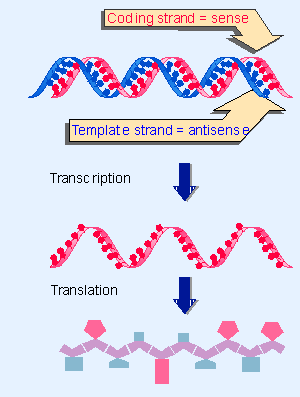1. Introduction
5.1 Introduction |
| Key terms defined in this section |
| Coding region is a part of the gene that represents a protein sequence. Coding strand of DNA has the same sequence as mRNA. template strand of double-stranded DNA is the one that is used to specify the sequence of a complementary single strand of RNA. (The non-template strand is identical in sequence to the RNA product.) Transcription is synthesis of RNA on a DNA template. Translation is synthesis of protein on the mRNA template. |
Gene expression occurs by a two-stage process.
- Transcription generates a single-stranded RNA identical in sequence with one of the strands of the duplex DNA. Several different types of RNA are generated by transcription. The three principal classes involved in the synthesis of proteins are:
- messenger RNA (mRNA)
- transfer RNA (tRNA)
- ribosomal RNA (rRNA)
- transfer RNA (tRNA)
- Translation converts the nucleotide sequence of RNA into the sequence of amino acids comprising a protein. An mRNA is translated into a protein sequence; tRNA and rRNA provide other components of the apparatus for protein synthesis. The entire length of an mRNA is not translated, but each mRNA contains at least one coding region that is related to a protein sequence by the genetic code: each nucleotide triplet (codon) of the coding region represents one amino acid.
 |
Figure 5.1 Transcription generates an RNA which is complementary to the DNA template strand and has the same sequence as the DNA coding strand. Translation reads each triplet of bases into one amino acid. Three turns of the DNA double helix contain 30 bp, which cide for 10 amino acids. |
Only one strand of a DNA duplex is transcribed into a messenger RNA. We distinguish the two strands of DNA as depicted in Figure 5.1:
- The strand of DNA that directs synthesis of the mRNA via complementary base pairing is called the template strand or antisense strand. (We see later that antisense is used as a general term to describe a sequence of DNA or RNA that is complementary to mRNA.)
- The other DNA strand bears the same sequence as the mRNA (except for possessing T instead of U), and is called the coding strand or sense strand.
In this chapter we discuss mRNA and its use as a template for protein synthesis. In 6 Protein synthesis we discuss the process of protein synthesis itself. In 7 Using the genetic code we discuss the way the genetic code is used to interpret the meaning of a sequence of mRNA. And in 8 Protein localization we turn to the question of how a protein finds its proper location in the cell when or after it is synthesized.
- Chapter II Information Search on the Internet: A Causal Model
- Chapter III Two Models of Online Patronage: Why Do Consumers Shop on the Internet?
- Chapter VI Web Site Quality and Usability in E-Commerce
- Chapter XIII Shopping Agent Web Sites: A Comparative Shopping Environment
- Chapter XVII Internet Markets and E-Loyalty